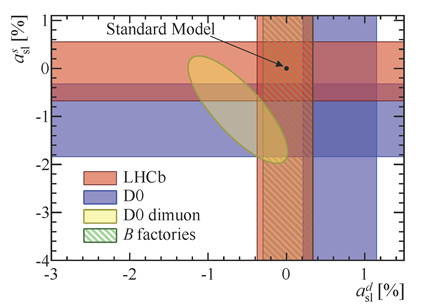Today at the International Workshop on the CKM Unitarity Triangle, CKM2014, Vienna, Austria, the LHCb collaboration has presented the results of a measurement of the semileptonic asymmetry, adsl, related to a difference between a probability of a beauty meson, B0, to oscillate into its antimatter partner, B0, and a probability of the reverse process (an introduction to beauty and charm oscillations can be found in the 7 November 2012 news item). Any difference in this probability would be a manifestation of what is called CP-violation. The label “d” indicates decays of B0 mesons composed of anti-beauty b and d quarks while “sl” (semileptonic) indicates that leptons, in this case muons, are present among decay products. When a B0 meson decays semileptonically, the charge of the lepton determines whether it was a decay of a matter B0 or anti-matter B0 meson. On the other hand a presence of a “wrong-sign” lepton in a decay of a B0 meson indicates that a transition to a B0 meson took place before decay. Therefore these “wrong-sign” B0 and B0 decays were used in the analysis. The measurement of the adsl is very interesting since its value is predicted to be very small by the Standard Model and therefore any significant deviation from zero could indicate a (so called virtual) contribution of not yet discovered particles in B0 – B0 oscillations.
LHCb physicists presented today a new preliminary value of adsl = (-0.02 ± 0.19 ± 0.30)% using the full 3 fb-1 2011 and 2012 data sample. The LHCb Collaboration has published recently a corresponding value for the strange beauty mesons B0s of assl = (-0.06 ± 0.50 ± 0.36)% using 1 fb-1 of data taken in 2011. Both results indicate no CP-violation to be present within the sensitivity of the measurements and hence are consistent with the very small values predicted by the Standard Model.
The LHCb results are shown in the image together with the Standard Model prediction.
The yellow ellipse shows a result from a measurement of the D0 experiment at the Tevatron which is sensitive to both adsl and assl. It lies a significant distance away from the prediction of the Standard Model and hence has excited interest as pointing to a break down in the theory, see 7 July 2012 news for introduction.
The LHCb results are consistent with the Standard Model but do not exclude the D0 result. LHCb will soon update the measurement of assl, which may clarify the situation.
Read more in the LHCb presentation in Vienna and soon in the forthcoming LHCb publication.
click the image for higher resolution

